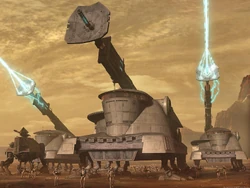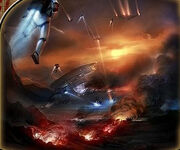| | |
- "…and I've always said, if Exar Kun had artillery at Toprawa, your Jedi Chancellor would be sporting yellow eyes today."
- ―Jarrow Rusher to Kerra Holt

Artillery was a term used to describe medium and heavy weapons systems or vehicles designed for long-range bombardment, generally against fortified targets such as bunkers and shield generators but also vehicles and infantry. Most artillery pieces were stationary, fed by high-output power generators, serviced by large crews and protected within armored housings, although many examples of mobile pieces existed.
Overview
Artillery were weapon systems designed for assaulting fortified positions such as enemy bases, cities, buildings, shield generators, and bunkers. Smaller artillery was designed specifically to target vehicles and enemy infantry. Most artillery pieces were stationary units crewed by several gunners, connected to high-output power generators and protected by strong armor. Some pieces were transported on repulsorlift chassis, allowing them to be used in mobile siege warfare.[2]
Line-of-sight artillery fired in a direct line, straight at a target. Blaster artillery and slugthrowers were considered to be light of sight weapons, and their ranges were limited due to the requirement of having to be able to see the target. The advantage that line-of-sight artillery offered was that the attacks were delivered extremely quickly, meaning that the target had no chance of avoiding it.[2]
Guided weapons such as missile launchers offered greater ranges that line-of-sight weaponry, and were capable of making midflight course corrections to home in on their targets. However, the homing systems on the missiles could be disrupted by countermeasure systems or shot down by antimissile defense systems.[2]
Unguided artillery were indirect fire weapons, such as missiles and shells that were fired with an arcing trajectory. These weapons had the greatest range, and were intended to hit targets behind cover or over the horizon line. Countermeasures were ineffective against them since they had no guidance systems, although they were vulnerable to antimissile fire.[2]
Artillery was divided into several categories. The smallest pieces were classified as light artillery, and were also colloquially referred to as "heavy weapons" or "infantry support weapons." Light artillery generally required more than one crew to operator, and were connected to portable power generators and were equipped with tripod mounts. Larger pieces were sometimes transported on repulsorlift trailers. Weapons such as BlasTech's T-21 light repeating blaster and the E-Web fell into this category, as did vehicle-mounted weapons such as repeating blasters, blaster cannons, missile racks, and grenade launchers.[2]
The optimal range of an artillery piece was the distance that its gunner expected to be able to hit a target. Its maximum range was the upper end of the weapon's targeting distance, although at this range a hit was unlikely though not impossible. The range of a weapon was affected by several factors; the efficiency of the artillery's targeting system and energy output. For blaster weapons, the range was determined by the galven circuitry's ability to keep the beam coherent over long distances.[2]
Projectile artillery rate of fire was determined by the speed at which the mechanical feeder could load ammunition into the firing chamber. For blaster weaponry, the rate of fire was controlled by the cooling ability of the acutating module. For both, the ammunition capacity of the weapon controlled how many times a weapon could fire before a reload was needed.[2]
Imperial Army
During the formation of the Imperial Army, artillery had been given the least priority of the combat arms, with the common thinking that artillery would play no significant role on modern battlefields. The Rebellion, however, proved them wrong and attempts were made to quickly revitalize this force. Officially an artillery regiment would be attached to a battlegroup and operate as a single unit. However due to some complaints by junior officers on occasion smaller artillery units were assigned at the regimental or battalion level, such as an artillery battery being attached to a line battalion, although this was not reflected in the Order of Battle.[3]
The Imperial Army classified artillery pieces in three major categories; light, medium and heavy. An artillery section would typically have a single heavy or medium artillery piece, or two light artillery pieces.[3]
Military organization
Artillery section
The smallest artillery formation in the Imperial Army was the artillery section. These squad sized units would typically consist of eight soliders. The section could sometimes be further divided into two four man gun crews each using a single light artillery piece or alternatively work together to crew a single medium or heavy artillery piece.[3]
Artillery line
An artillery line was comprised of four artillery sections along with a command element which consisted of a commanding officer at the rank of lieutenant and a sergeant major who served as the second-in-command of the unit. These lines could be augmented with the addition of two more artillery sections, a heavy weapons squad, and a line squad.[3]

Artillery line organizational chart on the Imperial Army Order of Battle
Artillery battery
The artillery battery was made up of four artillery lines, a command element and three support units. The logistics section was made up of eight logistics personnel, eighty-eight droids and a logistics officer. The medical team consisted of four medical personnel, eight droids and a medical officer. The technical group had eleven technical personnel, twenty-two droids and a technical officer. The battery could be augmented with the addition of two assault platoon and two more artillery lines.[3]

Artillery battery organizational chart on the Imperial Army Order of Battle
Artillery battalion
The artillery battalion consisted of three artillery batteries, an assault company, a security platoon and three support units. The artillery batteries conducted fire support missions, the assault company secured ground and defended the other units, while the security platoon only defended the captain. The argumentation process allowed the battalion to essentially double in strength.[3]

Artillery battalion organizational chart on the Imperial Army Order of Battle
Artillery regiment
The artillery regiment was the largest official artillery formation in the Imperial Army. It consisted of three artillery battalions, an assault battalion, a scout troop, and the traditional support and security units within the regimental headquarters. The regiment could be augmented with the addition of an repulsorlift battalion and three artillery battalions.[3]

Artillery regiment organizational chart on the Imperial Army Order of Battle
Appearances
Non-canon appearances
- LEGO Star Wars: The Video Game
- LEGO Star Wars II: The Original Trilogy
- LEGO Star Wars III: The Clone Wars
